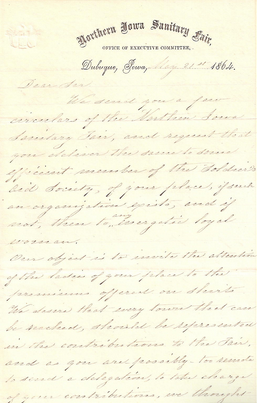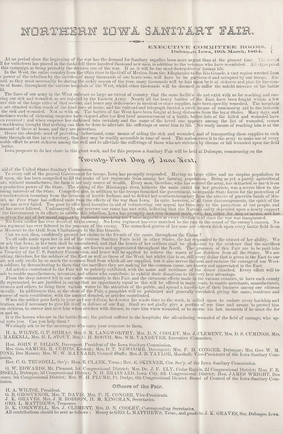Encyclopedia Dubuque
"Encyclopedia Dubuque is the online authority for all things Dubuque, written by the people who know the city best.”
Marshall Cohen—researcher and producer, CNN
Affiliated with the Local History Network of the State Historical Society of Iowa, and the Iowa Museum Association.
NORTHERN IOWA SANITARY FAIR
NORTHERN IOWA SANITARY FAIR. Twice as many men died of disease than of gunshot wounds in the CIVIL WAR. The overall poor hygiene made the typical camp a breeding ground for disease. Surgeons, along with their assistants, worked round the clock, ending up with stacks of amputated limbs up to five feet high. The number of wounded needing attention and the relative lack of water meant that there was no attempt to wash hands or instruments between procedures. (1)
In order to try and end these conditions, the Sanitary Commission tried to educate the army on proper sanitation techniques. The Sanitary Commission's report issued in 1861 was widely distributed and included many guidelines to improve sanitation and reduce disease. (2)
Sanitary fairs were civilian-organized bazaars and expositions dedicated to raising funds for the United States Sanitary Commission (USSC) and other charitable relief organizations. Over the course of the Civil War, they became one of the most popular means of fundraising for the Union cause. (3)
Sanitary affairs in Iowa during the Civil War were united under a single head which providied an efficient working system. A letter to the Muscatine Journal, however, indicates that there were still some people in the State who were not in sympathy with the arrangement. This letter referred to the Iowa Sanitary Commission as “conceived in sin and brought forth in iniquity” and declared that the Commission was “begging” the legislature for $80,000, of which $13,000 was to pay the salaries of its agents and officers. (4)
The organization of the Fair held on June 21-29, 1864, began in January. Clara Aldrich COOLEY, a member of the Dubuque County Committee, asked Iowans to hel establish an Iowa Cabinet of Minerals. A similar collection of minerals from Wisconsin had recently sold at the Sanitary Fair in Chicago for $1,000. (5) A representative from each of the cooperating counties was made a vice-president. The idea of the Fair had not met with universal local approval. On January 17, 1864 the Dubuque Democratic Herald had an editorial suggesting that if the women of Dubuque wanted to do something to lessen suffering they could form clubs and visit areas of the city in need. The newspaper also suggested that a Fair held in a city the size of Dubuque had little chance of making much of a difference. (6) The paper even congratulated the women for apparently rejecting the idea. (7) By April 27, 1864, however, the Committee of Catholic Ladies on Fancy Articles were planning a meeting on how they could contribute. (8)
The second annual meeting of the Iowa Sanitary Commission was held at Des Moines on June 1, 1864. Mr. Frederick Ezekiel BISSELL became president; Mrs. James Baker of Davenport, recording secretary; Ezekiel Clark of Iowa City was reelected treasurer; and Rev. E. S. Norris of Dubuque was made corresponding secretary and general agent. (9) The first meeting of the board of control of the Commission for 1864 was held at Dubuque on June 22-24, during the Northern Iowa Sanitary Fair. The officers of the local aid societies who were at the Fair attended the meeting of the board in large numbers. Mrs. D. P. Livermore of Chicago, representing the United States Sanitary Commission was present and told of the condition and sufferings of the Iowa troops, and explained the working of the Commission which she represented. The chief object of the meeting was to arouse an interest among the visitors at the Fair; and according to the report “all present were inspired with renewed determination to work with increased zeal”. (10)
Perhaps taking an idea from the previously mentioned editorial, thirty-two counties participated in the Northern Iowa Sanitary Fair. The event was held in the DUBUQUE CITY HALL. The first floor offered a series of booths along both sides of the undivided room. Library and floral departments were found on the second floor. The Children's Amusement Department, located on the third floor, was used for the display of battle relics and curiosities.
Refreshments were offered on the first two floors of Turner Hall located nearby. Hardware, agricultural and household implements, and machinery were displayed in an adjoining building erected for the Fair.
The opening of the Fair featured no parades. The Germania Band performed "Hail Columbia;" a prayer was offered; and H. A. Wiltse, president of the Fair, made a brief speech in which the donations were formally turned over to the committees. City of Dubuque donations were received from many associations including the Congregational Society, Universalist Society, Young Ladies' Aid Society, Second Presbyterian Society, Methodist Episcopal Society, and the Catholic Society. Mrs. O. P. Shiras donated a garden vase that brought forty dollars. Julius K. GRAVES donated the gas used for lighting the buildings. Four handmade handkerchiefs, donated by Mrs. John T. Hancock and Mrs. G. B. Grosvenor, brought forty-two dollars.
The Dubuque Fair was a great success. (11)
The receipts of the Fair, in money and stores, amounted in
value to nearly ninety thousand dollars. Over fifty thousand
dollars in cash, and one thousand nine hundred and sixty
packages of hospital supplies were sent by the Fair to the
Northwestern Branch of the Sanitary Commission at Chicago.
Unsold articles that could be turned into clothing were donated to the Ladies' Soldiers' Aid Society of Dubuque. Others items were donated to sanitary fairs in Illinois and elsewhere in Iowa.
---
Source:
1. "Civil War Medicine," Online: http://www.sonofthesouth.net/leefoundation/civil-war-medicine.htm
2. Ibid.
3. Bryan, Kerry L. "Civil War Sanitary Fairs," The Encyclopedia of Greater Philadelphia, Online: http://philadelphiaencyclopedia.org/archive/civil-war-sanitary-fairs/
4. "Activities and Accomplishments of the Commission," The Iowa Journal of History and Politics, January 1918, Volume 16, #2. Online: http://iagenweb.org/history/IJHP/IJHP2IA10.htm
5. "Iowa Cabinet of Minerals," Dubuque Herald, January 22, 1864, p. 4
6. "A Sanitary Fair," Dubuque Democratic Herald, January 17, 1864, p. 1. Online: https://news.google.com/newspapers?nid=A36e8EsbUSoC&dat=18640117&printsec=frontpage&hl=en
7. "No Sanitary Fair," Dubuque Democratic Herald, January 19, 1864, p. 4. Online: https://news.google.com/newspapers?nid=A36e8EsbUSoC&dat=18640119&printsec=frontpage&hl=en
8. "Northern Iowa Sanitary Fair,"Dubuque Democratic Herald," April 27, 1864, p. 4. Online: https://news.google.com/newspapers?nid=A36e8EsbUSoC&dat=18640426&printsec=frontpage&hl=en
9. "Activities and Accomplishments,"
10. Ibid.
11. Newberky, J. S. (Secretary-Western Department). Final Report The U.S. Sanitary Commission in the Valley of the Mississippi, During the War of the Rebellion, 1861-1866, p. 16. Online: http://www.archive.org/stream/cu31924014087203/cu31924014087203_djvu.txt
Swaim, Ginalie. "Thrown Upon Their Own Exertions," Iowa Heritage Illustrated, Spring, 2014. p. 33
See: LINT SOCIETIES
---








